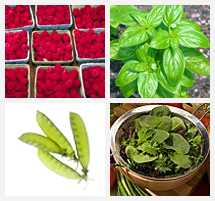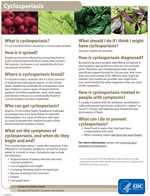Epidemiology & Risk Factors

Fresh imported raspberries, basil, snow peas, and mesclun lettuce have been implicated in U.S. outbreaks of cyclosporiasis since the mid-1990s. (Images: USDA)
People become infected with Cyclospora by ingesting sporulated oocysts, which are the infective form of the parasite. This most commonly occurs when food or water contaminated with feces is consumed. An infected person sheds unsporulated (immature, non-infective) Cyclospora oocysts in the feces. The oocysts are thought to require days to weeks in favorable environmental conditions to sporulate (become infective). Therefore, direct person-to-person transmission is unlikely, as is transmission via ingestion of newly contaminated food or water.
More on: Cyclospora Biology
Geographic Distribution
Cyclosporiasis occurs in many countries, but it seems to be most common in tropical and subtropical regions. In areas where cyclosporiasis has been studied, the risk for infection is seasonal. However, no consistent pattern has been identified regarding the time of year or the environmental conditions, such as temperature or rainfall.
In the United States, foodborne outbreaks of cyclosporiasis since the mid-1990s have been linked to various types of imported fresh produce, including raspberries, basil, snow peas, and mesclun lettuce; no commercially frozen or canned produce has been implicated.
U.S. cases of infection also have occurred in persons who traveled to Cyclospora-endemic areas. To reduce the risk for infection, travelers should take precautions, such as those recommended in CDC's Health Information for International Travel (Yellow Book). Travelers also should be aware that treatment of water or food with chlorine or iodine is unlikely to kill Cyclospora oocysts.
- Page last reviewed: January 10, 2013
- Page last updated: January 10, 2013
- Content source:



 ShareCompartir
ShareCompartir